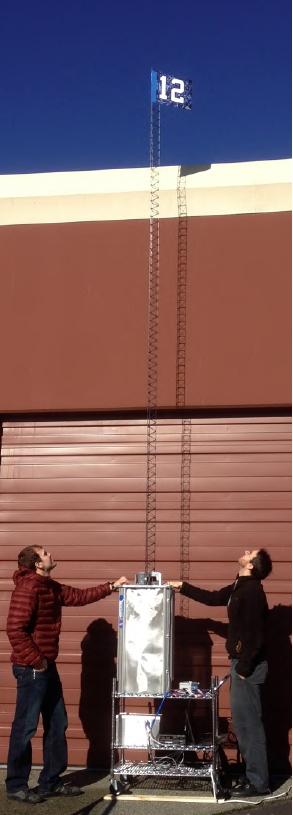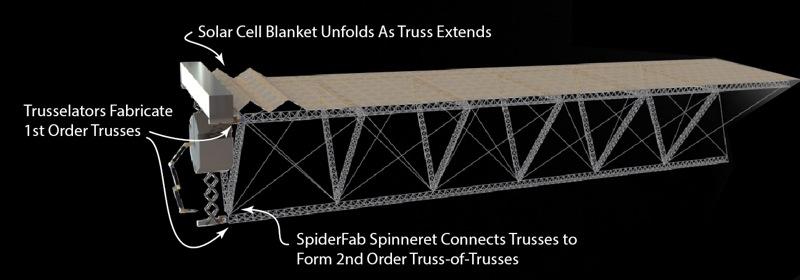The Trusselator is aimed at creating, through the use of in-space additive manufacturing, a series of high-performance trusses to handle large solar arrays and antennas, and NASA says Tethers Unlimited has been awarded $750,000 to continue development of the technology.
 The funds will come from the NASA Innovative Advanced Concepts (NIAC) program and the NASA Small Business Innovative Research (SBIR) program.
The funds will come from the NASA Innovative Advanced Concepts (NIAC) program and the NASA Small Business Innovative Research (SBIR) program.
It’s all part of a group of ideas Tethers Unlimited Inc. (TUI) is developing under the umbrella of their SpiderFab project, a plan to fabricate spacecraft components in Earth orbit.
The architecture of the project integrates elements of 3D printing, automated composite layup, and robotic assembly to build large, lightweight structures to support solar cells and reflectors.
It’s not small thinking as the various elements will be used to create antennas and solar arrays the size of a sports stadium.
The companies hope to solve a major problem with space travel: how developers can manufacture affordable space systems larger than those which can be built on the Earth and then launched inside a rocket.
“Developing the Trusselator device is the key first step in implementing the SpiderFab capability for in-space manufacturing,” says Dr. Robert Hoyt, CEO and Chief Scientist at TUI. “Our goal with this effort is to dramatically reduce the costs of building large systems in space. In the new SBIR effort, we will develop a prototype Trusselator designed to operate in the vacuum environment of space and test it in our new space simulation facility.”
Over the long haul, Hoyt says the idea of manufacturing spacecraft components in orbit will one day prove critical to projects like a manned missions to Mars.
The companies say the technology could also be used to create solar sails of enormous size, antennas for high-bandwidth communications, and masts many kilometers long for interferometric astronomy projects.
It all comes down to making improvements in packing efficiency and launch mass, and Phase I of the Trusselator effort has already demonstrated that fabrication of continuous lengths of high-performance carbon fiber truss, using a novel additive manufacturing process, have superior bending stiffness efficiency when compared to existing deployable mast technologies.
The company says Phase II of the effort will take on the the key technical risks and further develop the process by refining the additive manufacturing process elements the truss products, and then work on design and prototype elements of a “Trusselator” which can work in the “thermal-vacuum environment” of space. Do you think you’ll live to see the day when additive manufacturing processes are used to create huge projects in space? Let us know what you think in the Trusselator thread on 3DPB.com.
Subscribe to Our Email Newsletter
Stay up-to-date on all the latest news from the 3D printing industry and receive information and offers from third party vendors.
You May Also Like
Further Understanding of 3D Printing Design at ADDITIV Design World
ADDITIV is back once again! This time, the virtual platform for additive manufacturing will be holding the first-ever edition of ADDITIV Design World on May 23rd from 9:00 AM –...
3D Printer Maker EVO-tech Reborn as NEVO3D — Once More With Feeling
EVO-tech was a 3D printing service and original equipment manufacturer established in 2013 and based in Schörfling am Attersee, Austria. The company produced high-quality material extrusion systems featuring linear bearings,...
3D Systems Brings 3D Printed PEEK Cranial Implant to the U.S. with FDA Clearance
For more than 10 years, 3D Systems (NYSE:DDD) has worked hand-in-hand with surgeons to plan over 150,000 patient-specific cases, and develop more than two million instruments and implants from its...
CDFAM Returns to Berlin for Second Annual Symposium
The second CDFAM Computational Design Symposium is scheduled for May 7-8, 2024, in Berlin, and will convene leading experts in computational design across all scales. Building upon the first event...

































